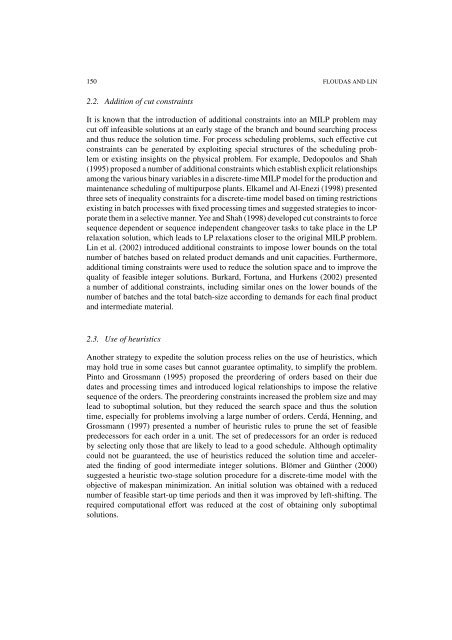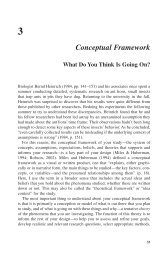Mixed Integer Linear Programming in Process Scheduling: Modeling ...
Mixed Integer Linear Programming in Process Scheduling: Modeling ...
Mixed Integer Linear Programming in Process Scheduling: Modeling ...
Create successful ePaper yourself
Turn your PDF publications into a flip-book with our unique Google optimized e-Paper software.
150 FLOUDAS AND LIN<br />
2.2. Addition of cut constra<strong>in</strong>ts<br />
It is known that the <strong>in</strong>troduction of additional constra<strong>in</strong>ts <strong>in</strong>to an MILP problem may<br />
cut off <strong>in</strong>feasible solutions at an early stage of the branch and bound search<strong>in</strong>g process<br />
and thus reduce the solution time. For process schedul<strong>in</strong>g problems, such effective cut<br />
constra<strong>in</strong>ts can be generated by exploit<strong>in</strong>g special structures of the schedul<strong>in</strong>g problem<br />
or exist<strong>in</strong>g <strong>in</strong>sights on the physical problem. For example, Dedopoulos and Shah<br />
(1995) proposed a number of additional constra<strong>in</strong>ts which establish explicit relationships<br />
among the various b<strong>in</strong>ary variables <strong>in</strong> a discrete-time MILP model for the production and<br />
ma<strong>in</strong>tenance schedul<strong>in</strong>g of multipurpose plants. Elkamel and Al-Enezi (1998) presented<br />
three sets of <strong>in</strong>equality constra<strong>in</strong>ts for a discrete-time model based on tim<strong>in</strong>g restrictions<br />
exist<strong>in</strong>g <strong>in</strong> batch processes with fixed process<strong>in</strong>g times and suggested strategies to <strong>in</strong>corporate<br />
them <strong>in</strong> a selective manner. Yee and Shah (1998) developed cut constra<strong>in</strong>ts to force<br />
sequence dependent or sequence <strong>in</strong>dependent changeover tasks to take place <strong>in</strong> the LP<br />
relaxation solution, which leads to LP relaxations closer to the orig<strong>in</strong>al MILP problem.<br />
L<strong>in</strong> et al. (2002) <strong>in</strong>troduced additional constra<strong>in</strong>ts to impose lower bounds on the total<br />
number of batches based on related product demands and unit capacities. Furthermore,<br />
additional tim<strong>in</strong>g constra<strong>in</strong>ts were used to reduce the solution space and to improve the<br />
quality of feasible <strong>in</strong>teger solutions. Burkard, Fortuna, and Hurkens (2002) presented<br />
a number of additional constra<strong>in</strong>ts, <strong>in</strong>clud<strong>in</strong>g similar ones on the lower bounds of the<br />
number of batches and the total batch-size accord<strong>in</strong>g to demands for each f<strong>in</strong>al product<br />
and <strong>in</strong>termediate material.<br />
2.3. Use of heuristics<br />
Another strategy to expedite the solution process relies on the use of heuristics, which<br />
may hold true <strong>in</strong> some cases but cannot guarantee optimality, to simplify the problem.<br />
P<strong>in</strong>to and Grossmann (1995) proposed the preorder<strong>in</strong>g of orders based on their due<br />
dates and process<strong>in</strong>g times and <strong>in</strong>troduced logical relationships to impose the relative<br />
sequence of the orders. The preorder<strong>in</strong>g constra<strong>in</strong>ts <strong>in</strong>creased the problem size and may<br />
lead to suboptimal solution, but they reduced the search space and thus the solution<br />
time, especially for problems <strong>in</strong>volv<strong>in</strong>g a large number of orders. Cerdá, Henn<strong>in</strong>g, and<br />
Grossmann (1997) presented a number of heuristic rules to prune the set of feasible<br />
predecessors for each order <strong>in</strong> a unit. The set of predecessors for an order is reduced<br />
by select<strong>in</strong>g only those that are likely to lead to a good schedule. Although optimality<br />
could not be guaranteed, the use of heuristics reduced the solution time and accelerated<br />
the f<strong>in</strong>d<strong>in</strong>g of good <strong>in</strong>termediate <strong>in</strong>teger solutions. Blömer and Günther (2000)<br />
suggested a heuristic two-stage solution procedure for a discrete-time model with the<br />
objective of makespan m<strong>in</strong>imization. An <strong>in</strong>itial solution was obta<strong>in</strong>ed with a reduced<br />
number of feasible start-up time periods and then it was improved by left-shift<strong>in</strong>g. The<br />
required computational effort was reduced at the cost of obta<strong>in</strong><strong>in</strong>g only suboptimal<br />
solutions.
















